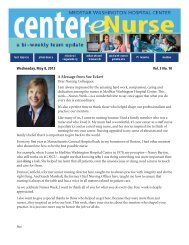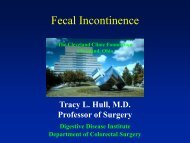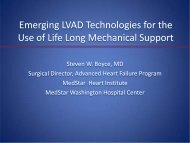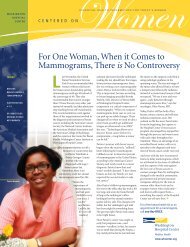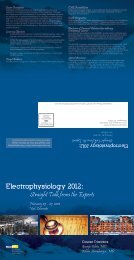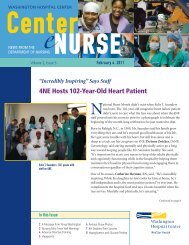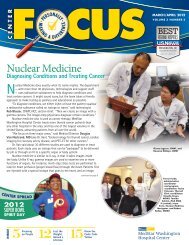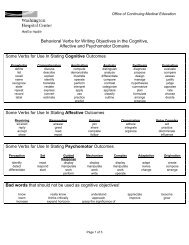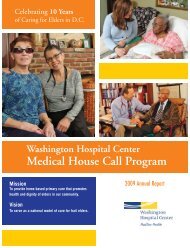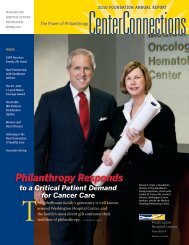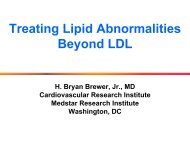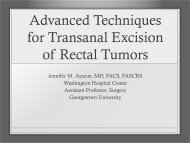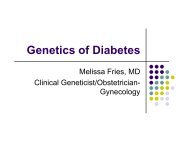Cardiovascular MRI: The Future is Now - Washington Hospital Center
Cardiovascular MRI: The Future is Now - Washington Hospital Center
Cardiovascular MRI: The Future is Now - Washington Hospital Center
You also want an ePaper? Increase the reach of your titles
YUMPU automatically turns print PDFs into web optimized ePapers that Google loves.
Assessment of Viability with CMR: What<br />
<strong>is</strong> the Value After the STICH Trial?<br />
Chr<strong>is</strong>topher M. Kramer MD<br />
Ruth C. Heede Professor of Cardiology<br />
Professor of Radiology<br />
Director, <strong>Cardiovascular</strong> Imaging <strong>Center</strong><br />
University of Virginia Health System
Noninvasive assessment of viability<br />
1. Quantitative SPECT<br />
• > 50 % uptake of tracer ( 201 Tl, sestamibi, tetrofosmin)<br />
2. PET imaging<br />
• m<strong>is</strong>match between flow and metabol<strong>is</strong>m (FDG)<br />
3. FDG SPECT<br />
4. Low dose dobutamine echocardiography<br />
• inotropic reserve<br />
5. Contrast echocardiography<br />
• integrity of microcirculation<br />
6. CMR<br />
• inotropic reserve; late gadolinium enhancement
Viability testing and outcomes<br />
Annual Cardiac Death Rate (%)<br />
20<br />
16<br />
12<br />
8<br />
4<br />
0<br />
3.2<br />
-80%<br />
p
Viability imaging – does it matter?<br />
430 patients<br />
Randomized to PET<br />
guided arm vs. standard<br />
care<br />
Death, MI, or cardiac<br />
hospitalization<br />
Benefits in those who<br />
adhered to PET<br />
recommendations<br />
Beanlands R et al, J Am Coll Cardiol 2007;50:2002-12
STICH Trial<br />
Velasquez EJ et al, NEJM 2011;364:1607-16
STICH Trial<br />
Bonow RO et al, NEJM 2011;364:1617-25
Limitations of STICH<br />
Crossover in 17% medical arm, 9 % in CABG arm<br />
Small proportion randomized<br />
2 patients per site randomized per year on average<br />
Viability substudy pts. not randomized<br />
Viability testing optional – only ½ of pts. from main trial<br />
Differences in baseline character<strong>is</strong>tics<br />
Limited tests for viability – DSE, SPECT<br />
Binary classification of viability<br />
Revascularization not guided by presence of viability<br />
Small n with nonviability<br />
P Chareonthaitawee et al, JACC Img 2012;5:550-8
Viability by CMR<br />
Late gadolinium enhancement<br />
Dobutamine – contractile reserve<br />
Techniques<br />
Applications – acute MI, chronic <strong>is</strong>chemia<br />
Prognos<strong>is</strong>
Infarct detection/transmurality<br />
Technique - inversion recovery, nulling of<br />
normal myocardial signal<br />
Infuse 0.15 mM/kg of Gd-DTPA<br />
Image 10-20 minutes later –<br />
Gd becomes trapped<br />
in necrotic scar,<br />
delayed washout<br />
Simonetti et al Radiology 2001;218:215
Viability - Delayed hyperenhancement<br />
Kim, RJ et al Circulation 1999;100:1992-2002
Size of HE<br />
Choi et al Circulation 2001;104:1101-1107
Transmural extent of HE<br />
Transmural extent of hyperenhancement<br />
(%)= area A x 100 / (area A + area B)<br />
Kim, et al. N Engl J Med 2000;343: 1445-53
Reproducibility<br />
48 pts., 3 centers<br />
Imaged x 2, 0.15mM/kg Gd<br />
Wagner A et al. J Am Coll Cardiol<br />
2006;47:2027-33
Improved sensitivity vs. SPECT<br />
6 pts. (13%) with<br />
subendocardial<br />
infarction had no<br />
evidence of<br />
infarction by SPECT<br />
85/181 segments with<br />
subendocardial<br />
infarction had<br />
negative SPECT<br />
Wagner A, et al. Lancet 2003;9355:374
SPECT vs. CMR<br />
78 pts. acute MI at day 7<br />
Ibrahim T et al, J Am Coll Cardiol, 2007;49:208-16
Detecting unrecognized infarcts<br />
ICELAND MI study<br />
936 pts., 67-93 yrs.<br />
91 recognized MI<br />
157 unrecognized MI<br />
6.4 yrs. f/u<br />
Adjusted HR 1.45<br />
Absolute r<strong>is</strong>k↑ 8%<br />
Schelbert E et al, JAMA, 2012;308:890-896
LGE and prognos<strong>is</strong><br />
Kwong, RY et al.<br />
Circulation 2006;<br />
113:2733-2743
Acute MI - Contrast patterns<br />
Hyperenhancement Hyperenhancement +<br />
Microvascular obstruction
Regional function<br />
%S<br />
30<br />
25<br />
20<br />
15<br />
10<br />
5<br />
0<br />
*p
Pers<strong>is</strong>tent hypoenhancement - no-reflow<br />
Event-free survival (CV death,<br />
reinfarction, CHF, or stroke) for<br />
patients with and without <strong>MRI</strong> no<br />
reflow<br />
Wu, KC. Circulation 1998;97:765-772.
Time to reperfusion<br />
Tarantini G et al, J Am Coll Cardiol 2005;46:1229-1235
Infarct involution<br />
Ingkan<strong>is</strong>orn WP et al, J Am Coll Cardiol, 2004;43:2253<br />
Choi CJ et al, J Cardiovasc Magn Reson, 2004;6:915-23
AMI – T2-W edema imaging – area at r<strong>is</strong>k<br />
Abdel-Aty H et al.<br />
J<strong>MRI</strong> 2007;26:452-9<br />
Friedrich M et al.<br />
J Am Coll Cardiol<br />
2008;51:581-7
T2-W – edema/area at r<strong>is</strong>k<br />
Day 0 Day 1
T2-W – edema/area at r<strong>is</strong>k
T2-W/prognos<strong>is</strong><br />
Eitel I et al<br />
JACC<br />
2010;<br />
55:2470-9
Hibernation - Late gadolinium enhancement<br />
50 pts. imaged before revascularization<br />
804/2093 segments dysfunctional at baseline<br />
694/2093 had areas of hyperenhancement<br />
Kim R et al. N Engl J Med. 2000;343:1445
Viability – Late gadolinium enhancement<br />
Kim R et al. N Engl J Med. 2000;343:1445
LGE vs. PET<br />
31 pts., <strong>is</strong>chemic LV dysf., EF 28±9%<br />
PET and delayed enhancement <strong>MRI</strong><br />
11% PET viability showed some HE<br />
C Klein Circulation 2002;105:162
LGE vs. PET<br />
26 pts. w/ LV dysf.<br />
EF 31 11%<br />
FDG-PET, SPECT,<br />
and CMR<br />
17-segment model<br />
HP Kuhl et al. J Am Coll Cardiol 2002;105:162
Viability – Late gadolinium enhancement<br />
Kim et al, N Engl J Med<br />
2000;343:1445
Viability - dobutamine cine <strong>MRI</strong><br />
Functional recovery as gold standard (SWT >2mm)<br />
Sens. 89%, Spec. 94%, better than EDWT<br />
↑EF with contractile reserve (14±9% vs. 3±9%, )<br />
Baer et al, JACC<br />
1998:31:1040
Viability - dobutamine tagged <strong>MRI</strong><br />
17 patients (12 male)<br />
Age 63 9<br />
Ischemic LV dysfunction<br />
<strong>MRI</strong> before and 5 2<br />
months after revasc.<br />
Baseline 5 µg/kg/min Dob<br />
10 µg/kg/min Dob<br />
Follow up<br />
Samady et al, Circulation, 2004;110:2410-6
Results<br />
All 180 Segments<br />
Rest %S<br />
Postrevascularization<br />
40<br />
30<br />
20<br />
10<br />
0<br />
-10<br />
-20<br />
y = 0.61x +5.4<br />
r = 0.55, P < 0.001<br />
-10<br />
0<br />
Peak dobutamine %S<br />
Pre-revascularization<br />
10<br />
20<br />
Samady et al, Circulation, 2004;110:2410-6<br />
30<br />
40
Example images – nonviable segment<br />
30% HE<br />
Baseline Dobutamine<br />
Follow-up<br />
nonviable<br />
C Bove et al, Radiology<br />
2006; 240:835-41
Subendocardial MI – 1-50% HE<br />
C Bove et al, Radiology<br />
2006; 240:835-41<br />
* p
Contrast vs. dobutamine<br />
All<br />
segments<br />
1-75%<br />
TEH<br />
No scar or<br />
transmural<br />
scar<br />
25% or 50%<br />
cutoff<br />
Wellnofer et al, Circulation<br />
2004;109:2172-2174
Meta-analys<strong>is</strong><br />
J Romero et al, JACC CV<br />
Imaging 2012;5:509-12
Conclusions<br />
If viability <strong>is</strong> of interest in clinical dec<strong>is</strong>ion<br />
making, CMR <strong>is</strong> an excellent technique to use<br />
Late gadolinium enhancement <strong>is</strong> a well-validated,<br />
accurate method of infarct sizing<br />
Prognostic information of LGE continues to grow<br />
Late gadolinium enhancement and low dose<br />
dobutamine contractile reserve are<br />
complementary in the assessment of likelihood<br />
of contractile recovery



